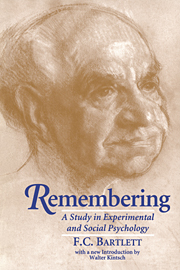Book contents
- Frontmatter
- Contents
- Biography of Sir Frederic C. Bartlett
- Introduction by Walter Kintsch
- Preface
- PART I EXPERIMENTAL STUDIES
- PART II REMEMBERING AS A STUDY IN SOCIAL PSYCHOLOGY
- Chapter XIII Social Psychology
- Chapter XIV Social Psychology and the Matter of Recall
- Chapter XV Social Psychology and the Manner of Recall
- Chapter XVI Conventionalisation
- Chapter XVII The Notion of a Collective Unconscious
- Chapter XVIII The Basis of Social Recall
- Chapter XIX A Summary and Some Conclusions
- Index
- Plate section
Chapter XVI - Conventionalisation
Published online by Cambridge University Press: 04 August 2010
- Frontmatter
- Contents
- Biography of Sir Frederic C. Bartlett
- Introduction by Walter Kintsch
- Preface
- PART I EXPERIMENTAL STUDIES
- PART II REMEMBERING AS A STUDY IN SOCIAL PSYCHOLOGY
- Chapter XIII Social Psychology
- Chapter XIV Social Psychology and the Matter of Recall
- Chapter XV Social Psychology and the Manner of Recall
- Chapter XVI Conventionalisation
- Chapter XVII The Notion of a Collective Unconscious
- Chapter XVIII The Basis of Social Recall
- Chapter XIX A Summary and Some Conclusions
- Index
- Plate section
Summary
THE PROCESS OF CONVENTIONALISATION
The greatest stimulus to social change probably always comes from outside the strict limits of the changing group. This is the primary psychological reason why large and important organisations, such as an army, have groups of attachés, or liaison officers, with alien friendly organisations; why commercial undertakings or other associations often form selected groups among themselves with more intimate interrelations than they possess with similar bodies outside of the special grouping, and why, in the world as we know it, there have grown up any number of elaborate methods of facilitating contact between social groups. Yet when a technique, a custom, or an institution is adopted into one group from another, by whatsoever means, the selective conservation of the recipient group always works it into a pattern which is distinctive of itself. It is this process of the development of characteristic patterns within the group, into which all alien material that is retained must be fitted, that we are now to study. The emphasis passes, for the moment, away from psychology, in the strict sense, towards sociology. It is not with emotions, images, ideas, individual attitudes, that we are concerned, but with objective changes of culture. The general name which, as I have already stated, I propose to use to cover the whole of the processes involved is conventionalisation. The problem is: Here is an element of culture coming into this group from another. What are the main principles of the changes it must undergo before it finally settles down to an accepted form in its new social setting? The range of this question is immense.
- Type
- Chapter
- Information
- RememberingA Study in Experimental and Social Psychology, pp. 268 - 280Publisher: Cambridge University PressPrint publication year: 1995



